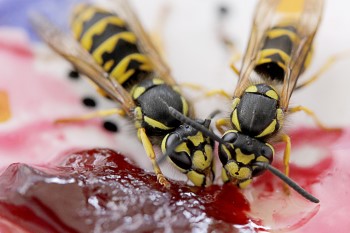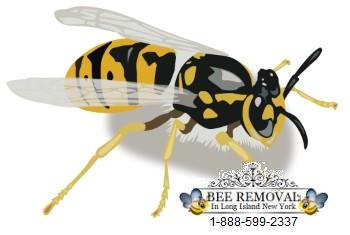YELLOW JACKETS LONG ISLAND, NEW YORK
Yellowjacket is standard nomenclature for a predatory social wasp of the genera Vespula. The European yellowjackets, also known as the German wasps, are native to Europe, Northern Africa, and temperate Asia but have been introduced and are well-established in southern Africa, New Zealand, eastern Australia, North America, and South America. German wasps can now be found on every continent but Antarctica. The European yellow jacket is a cavity-nesting wasp that first appeared in Ohio in 1975 and has become the dominant yellowjacket species in the United States. Eastern Yellowjackets build their nests underground, usually in abandoned rodent burrows. There are six species of yellow jackets found on Long Island, New York, which include the (1) German wasp, (2) Eastern yellowjacket, (3) Northern yellowjacket, (4) Southern yellowjacket, (5) Aerial yellowjacket, and the (6) Bald-faced hornet. Except for bald-faced hornets, these wasps, which measure approximately 1/2 inch in length, are usually black and yellow and are important predators of pest insects, such as caterpillars, grubs, flies, and spiders. These stinging flying insects are also opportunistic scavengers and will feed on meat from carcasses, fruit, processed human food, and trash. Yellowjackets are social insects that exist in colonies containing one to three thousand worker wasps. Depending on the yellowjacket species, they will construct nests in trees, shrubs, sheds, soil, tree stumps, attics, crawl spaces, and wall voids in Long Island homes. Yellowjackets are considered the most dangerous stinging insects in the United States. It is a bold and incredibly aggressive wasp that will repeatedly sting a perceived intruder. Yellowjackets have lance-like stingers with small barbs. Wasp stings are extremely painful and can result in anaphylactic shock in those that are allergic. Contact the wasp nest removal experts at Long Island Bee Removal, and we will remove the yellow jacket nest so that you won't get stung.
YELLOWJACKET LIFE CYCLE & REPRODUCTION NASSAU COUNTY, LONG ISLAND
In the Spring, a yellow jacket queen will construct a nest, which will rapidly grow in size during the summer months and give rise to many worker wasps. The nest is built using a paper-like substance that the wasps make by mixing their saliva with chewed, weathered wood. Yellowjacket nests are arranged in layers of brood cells where the wasp larvae are reared. As summer nears its end, the growth rate of the wasp nest slows down. Now more male wasps, known as drones, are produced than female workers. The nest will give rise to new queen wasps during the fall, which will mate and hibernate. The old yellowjacket queen, drones, and worker wasps perish at the end of the season, while the new hibernating fertilized queen wasps survive to repeat the cycle the following year. Yellowjacket wasps will not use the same nest in the next year.










